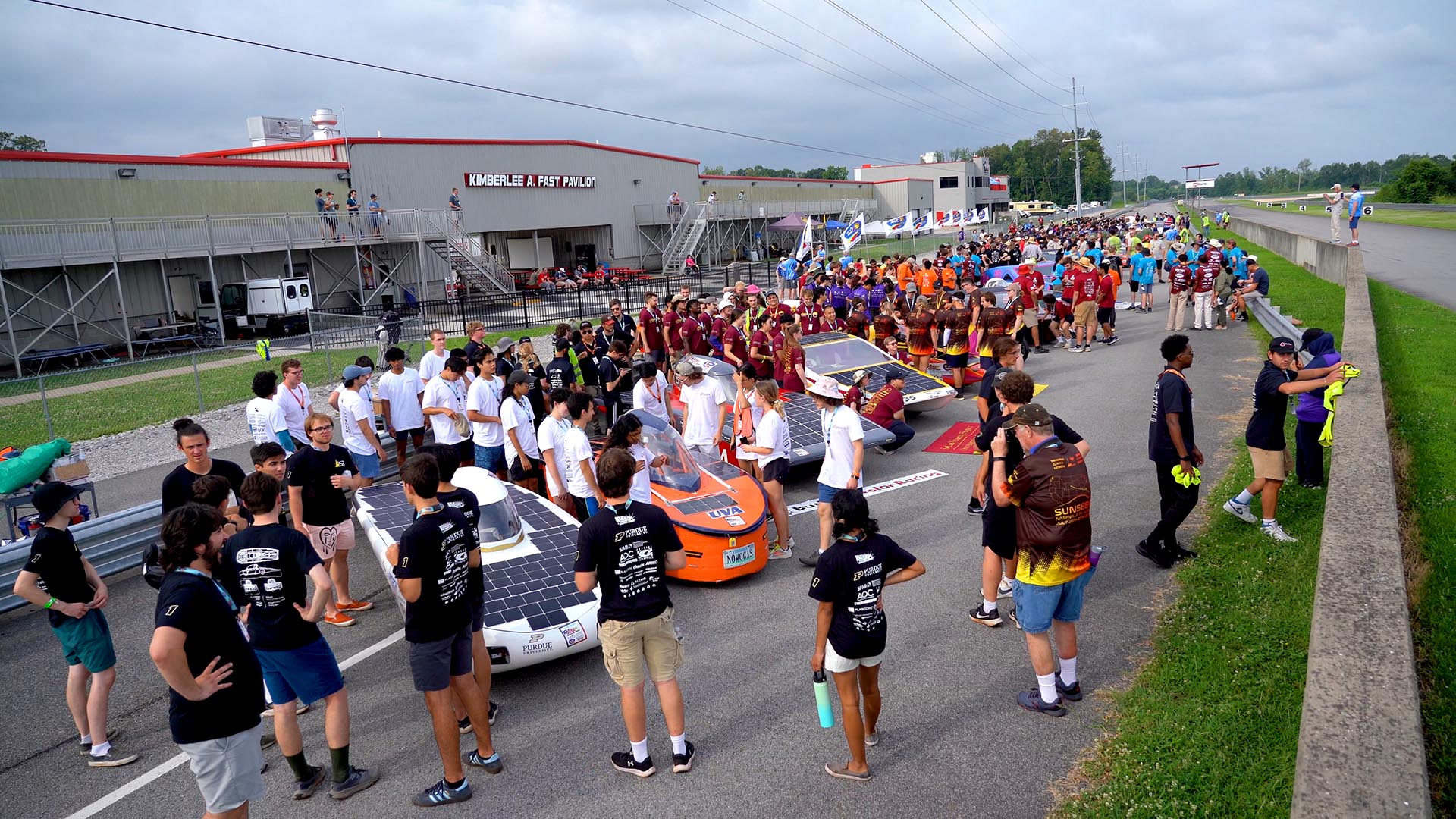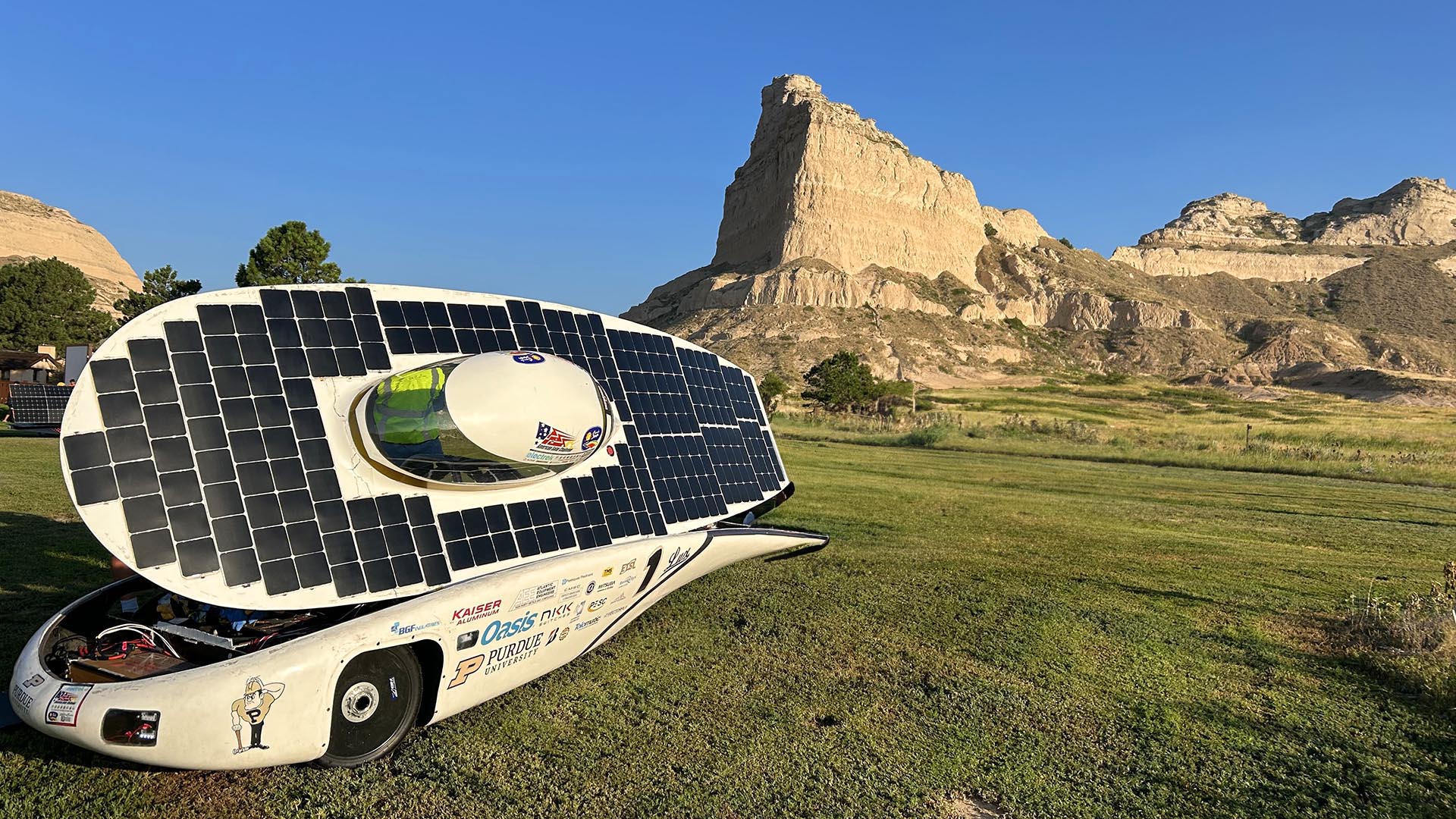Speed of light: Purdue Solar Racing successfully completes cross-country rally
Imagine driving 1,500 miles — from Nashville to Wyoming — without ever needing to refuel or recharge. That’s exactly what the students of Purdue Solar Racing accomplished in 2024: designing, building, and racing a custom solar-powered vehicle, which completed the American Solar Challenge for the first time in two decades.
On a sweltering 97-degree day at the National Corvette Museum in Bowling Green, Kentucky, the racetrack has been taken over — not by roaring V8s, but by teardrop-shaped electric vehicles that barely make a sound.
It’s day 1 of the Formula Sun Grand Prix. More than 30 university teams have brought their custom-made solar-powered vehicles to this proving ground, which serves as a qualifier for next week’s cross-country rally. You’d think they’d be overjoyed at the intense sunshine, but it’s actually a double-edged sword.
“The solar panels might love the photons, but the battery does not love the heat,” says Alexandre Chevalier, mechanical engineering student and president of Purdue Solar Racing. “We have strict guidelines of what conditions our battery can operate in, and once it gets past a certain temperature, we’re required to have our onboard software cut off charging the battery. And if the battery isn’t charged, obviously the car doesn’t go.”
Chevalier looks concerned as his team of software engineers work the problem. But considering what it took to get their car to this point, he has good reason to be optimistic about his team's chances.

A stellar legacy
Purdue Solar Racing began in 1991, with a van that students strapped solar panels to. The next year, aerodynamics students offered their expertise, creating vehicles with the familiar teardrop shape. Competing in the Sunrayce (the American Solar Challenge’s predecessor), Purdue vehicles made several cross-country treks in the 1990s, but never earned any trophies.
That changed in the 2000s when Purdue began competing in the Shell Eco-Marathon, a new showcase for efficient vehicles. From 2008 to 2013, Purdue Solar Racing scored four consecutive 1st place finishes in the Solar Prototype class, and two 1st place wins in the Battery-Electric class.
Then, the team went dormant. “When I applied to Purdue, solar racing was one of the groups I wrote about in my application essay,” says Chevalier. “But when I arrived to campus, they hadn’t competed in a decade. The ambitions were there, but the team wasn’t.”
That lack of institutional knowledge — plus the turmoil caused by COVID — seemed to deal a crushing blow to Chevalier’s dreams. But he remained determined, and began to assemble a team. “We had to learn everything from scratch,” said Chevalier. “Building a composite chassis, figuring out the suspension dynamics, writing the software, doing the wiring.”
Rather than shoot the moon on a solar car, Chevalier decided to start small: building a battery-powered electric car for the 2023 Shell Eco-Marathon in Indianapolis. The result, “Apollo,” had the same familiar aerodynamic body shape, but was more of an urban concept vehicle with two side doors, rear view mirrors, windshield wipers, trunk space, and regenerative breaking. With 1.5 square meters of solar panels, Apollo could go 20 miles per hour and remain energy-neutral, meaning the sun alone could provide all the necessary energy to power the car at that speed. Despite being just a prototype, Apollo finished 2nd in the “Urban Concept Battery-Electric” class.
“Leading up to the competition, we would roll the car out on the road every night, and for three weeks it would just never go,” said Chevalier. “And then one night, when we pressed the pedal, it went! We were all jumping up and down, we were so thrilled.”
Let your light shine down
Inspired by the success of Apollo, Purdue Solar Racing set to the task of building a proper solar endurance car, and entering the American Solar Challenge for the first time in two decades. “We learned a lot from Apollo,” said Chevalier. “We integrated all those lessons into improvements for the 2024 car. That’s what I’m most proud of, that we were able to move forward and show progress and grow as a team. Many people said it was impossible to build a car like this in just a year. But the first time we rolled this new car out of the garage, it actually went!”
They named their 2024 car “Lux” (Latin for “light”), and light it is — the vehicle weighs just 400 pounds. It’s also very aerodynamic, with a drag coefficient of 0.1, thanks to the students’ endless design iterations and the carbon fiber composite body. “Carbon fiber is a challenge to work with, especially at these sizes,” said Chevalier. “Thankfully, Purdue has many people and facilities that could help us, such as the Bechtel Innovation Design Center and the Composites Manufacturing and Simulation Center.”
The solar panels are also unique. “Traditional solar panels are under glass, and can be quite heavy,” said Chevalier. “To save weight, we custom-made this array ourselves. We took individual solar cells and encapsulated them in layers of plastic to match the aerodynamic shape of the vehicle. From there, it’s a lot of soldering and wiring.”
The rules allow up to 4 square meters of solar panels, and that’s what Lux has. At 24% efficiency, they top out generating 1.2 kilowatts of electricity, which is four times what their predecessor cars had in the 2000s. That sounds impressive, but...
“That’s only about a toaster’s worth of electricity,” laughs Chevalier. “That’s why we have to make the car so light and aerodynamic, so our battery can squeeze as much power out of that toaster as possible.”

Which takes us back to that 97-degree day in Kentucky. Team members from Principia College and Western Michigan University huddle around Purdue’s battery box, offering to share their battery management solutions. This cross-team camaraderie is common at university motorsports events, and in this case it pays off — the vehicle springs to life, and heads for the qualification area.
The Formula Sun Grand Prix is a track event, and to gain entry to the track, the car must pass many inspections. Industry judges scrutinize everything: the size of the vehicle, ground clearance, wiring, lights, visibility, safety features, battery management software. After getting the greenlight in those categories, Lux is cleared to participate in dynamic tests like slalom, braking, and acceleration. Near the end of the day, they get the final green sticker: permission to race on the track.
“Our vehicle isn’t meant to be powerful; it’s meant to be efficient,” said Chevalier. “That’s why this track event is so challenging. Our car was engineered to go straight and flat for as long as possible, and this course has lots of curves and elevation changes. We even have special tires from Bridgestone that are designed to minimize rolling resistance, not grip the asphalt in a tight corner.”
It's a moot point: half a lap in, the battery cries uncle. Chevalier is able to nurse the car back to pit road, but their racing day is over. And with thunderstorms cancelling racing the next day, they’re worried they might not finish the 200 miles required to qualify for the cross-country rally.
“The next day the track opened, we were on the start line right at 9:00 a.m.,” said Chevalier. “We completed our first laps, and then the next driver did his laps, and then we just kept going. The car didn’t stop all day, except to switch drivers. By the end of the day, we had completed 70 laps, which only two other teams ever did. We completed our required 200 miles all in one day, with about 15 minutes to spare!”

Sea to shining sea
Having qualified for the American Solar Challenge, Purdue now faced an entirely different task: a cross-country rally. Starting in Nashville, Tennessee, teams would start driving west on public roads, attempting to reach a different National Park every night. While support vehicles would accompany the race cars, it's still a significant test of endurance for the drivers.
Purdue had an inauspicious start. “One of our drivers was complaining about a noise on the right front wheel,” said Gus Brannock, mechanical lead for the team. “We told him it was just the brake discs rubbing on the pads, but he insisted it was something else. And he was right — the wheel was about to fall off! Thankfully we caught it in time, because if the wheel had fallen off, our chassis would have been crushed, which would have been game over on day 1.”
They soldiered on for a week — travelling through the prairies of southern Illinois, central Missouri, and parts of Kansas and Nebraska — camping at National Park sites along the way. “The point of the solar car is efficiency, so we kept it pretty much at 30 miles an hour the whole way,” said Chevalier. “Mile after mile of cornfields can get a little monotonous. One time a train was passing by, and we just floored it to see if we could keep up, and we got it up to about 55! Another time, our chase car actually rammed into the back of the solar car, because they took their eyes off the road for just one second. Thankfully there wasn’t too much damage.”
The team’s patience was rewarded at the penultimate stop: the impressive buttes of Scotts Bluff National Monument in western Nebraska. “After driving through flatlands for so long, we were so happy to finally see some scenery!” said Chevalier. “The downside was, it began to pour down rain, which it hadn’t done the entire week. Thankfully we were given some extra time in the morning to charge our cars, so we could finish the final leg.”

Just 180 miles later, they had arrived at the final stage in Casper, Wyoming. “The last day was pretty memorable,” said Brannock. “They had a cool ceremony where all of us ran alongside the car as it crossed the finish line. We exchanged shirts with members of the other teams. It was such an amazing feeling to know that we had finished the race.”
As for the final results, 30 teams had brought solar cars to the National Corvette Museum. Nine qualified for the cross-country rally, and six (including Purdue) crossed the finish line in Wyoming. In all, Purdue completed 1,286 miles of the 1,500-mile course, averaging 23 miles an hour over the entire distance — without once plugging their car into an outlet.
“Our goal this year was to finish, and we accomplished that in a big way,” said Chevalier. “For college students to build a car that is road-legal in just one year, and drive 1,500 miles using only solar power, that’s a pretty big feat of engineering!”
“Our car definitely turns heads,” says Brannock. “People are so curious what it’s about, and how different it is from other kinds of race cars. It’s a great way to draw attention to what’s possible in the future.”
“My favorite part of the whole experience is the people,” said Chevalier. “Every team member is valuable, from the mechanical team to the software team to the people driving the chase cars and doing logistics. We’re all here to support each other. When you see these students coming together and making progress on the daily, it really motivates you to keep on going.”

Writer: Jared Pike, jaredpike@purdue.edu, 765-496-0374
Source: Purdue Solar Racing, https://purduesolar.org
